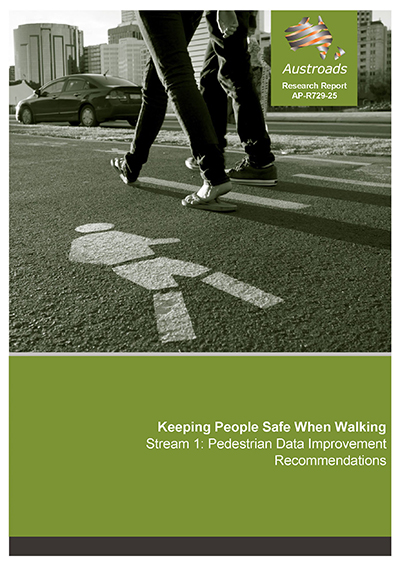Road Safety

- Publication no: AP-R729-25
- ISBN: 978-1-922994-65-3
- Published: 21 March 2025
- PDF (free) Download
This report provides recommendations to improve pedestrian data systems in Australia and New Zealand to enhance pedestrian safety.
The methodology combined theoretical research and stakeholder input through a literature review, focus groups, surveys, expert interviews, and analysis of existing pedestrian data. This approach highlighted the complexities of pedestrian safety data. Central to the project was the Austroads members workshop, where stakeholder discussions from federal, state/territory, and local governments refined the recommendations.
The outcome is 3 specific pedestrian data improvement recommendations to support a strategy for pedestrian safety. The report emphasises the need for collaboration among governments and road safety partners for effective implementation, vital for achieving sustainable pedestrian mobility and Vision Zero targets in Australia and New Zealand.
This is the third of the 4 reports produced as part of Austroads’ Keeping People Safe When Walking – Stream 1 project:
- Keeping People Safe when Walking – Stream 1: Pedestrian Safety Problem and Project Methodology
- Keeping People Safe when Walking – Stream 1: Literature Review
- Keeping People Safe when Walking – Stream 1: Pedestrian Data Improvement Recommendations [this report]
- Keeping People Safe when Walking – Stream 1: Recommended Pedestrian Safety Interventions
Join us for a webinar on Thursday 17 April presented by Dr Hafez Alavi, Dr Shane Turner and Lewis Martin to learn more about this project.
There will be question and answer opportunities during the session. No charge but registration is essential. Can’t make the live session? Register and we’ll send you a link to the recording.
- Summary
- 1. Introduction
- 1.1 Purpose
- 1.2 Scope
- 1.3 Methodology
- 1.3.1 Pedestrian data needs for safety analysis
- 2. Pedestrian Data Needs Framework
- 2.1 A pedestrian Safe System model to achieve significant pedestrian trauma reductions
- 2.2 Pedestrian data needs
- 2.2.1 Victoria’s walking and cycling data (framework and action plan) – 2018
- 3. Pedestrian Data Needs and Improvement Opportunities: Findings of Literature Review and Stakeholder Engagement Activities
- 3.1 Literature review findings
- 3.1.1 Key pedestrian data needs
- 3.1.2 Current pedestrian data sources and systems in Australia and New Zealand
- 3.1.3 Best practices of pedestrian data systems and data collection
- 3.1.4 Pedestrian data systems and data collection improvements for Australia and New Zealand
- 3.2 Focus group findings
- 3.2.1 Key pedestrian data needs
- 3.2.2 Current pedestrian data sources and systems in Australia and New Zealand
- 3.2.3 Best practices of pedestrian data systems and data collection
- 3.2.4 Pedestrian data systems and data collection improvements for Australia and New Zealand
- 3.3 Online Survey Findings
- 3.3.1 Key pedestrian data needs
- 3.3.2 Current pedestrian data sources and systems in Australia and New Zealand
- 3.3.3 Best practices of pedestrian data systems and data collection
- 3.3.4 Pedestrian data systems and data collection improvements for Australia and New Zealand
- 3.4 In-depth interview findings
- 3.4.1 Key pedestrian data needs
- 3.4.2 Current pedestrian data sources and systems in Australia and New Zealand
- 3.4.3 Best practices of pedestrian data systems and data collection
- 3.4.4 Pedestrian data systems and data collection improvements for Australia and New Zealand
- 3.5 Synthesis of key literature review and stakeholder engagement findings
- 3.5.1 What are the key pedestrian data needs in Australia and New Zealand?
- 3.5.2 What are some of the strengths and limitations of existing pedestrian data sources and systems currently in use in Australia and New Zealand?
- 3.5.3 What are the identified best practices in the collection, management, and analysis of pedestrian data systems in the context of urban planning and road safety?
- 3.5.4 What improvements can be made to the pedestrian data systems and data collection processes to enhance pedestrian safety in Australia and New Zealand?
- 3.1 Literature review findings
- 4. An In-Depth Inventory, Collation and Review of Pedestrian Data Sources in Australia and New Zealand
- 4.1 Method
- 4.2 Pedestrian data scoring criteria
- 4.2.1Scoring framework overview
- 4.3 Analysis of pedestrian data sources
- 4.3.1Ideal, good and acceptable pedestrian
- 4.4 Case studies and examples
- 4.4.1Analysis of example datasets
- 4.5 Opportunities for dataset improvements
- 5. Pedestrian Data Gap Analysis
- 5.1 Final gap analysis and synthesis method
- 5.2 A synthesis of the gaps identified in literature review, stakeholder engagement, Australasian dataset assessments, and the gap analysis
- 5.3 Austroads members workshop
- 5.3.1 A summary of preliminary recommendation areas and workshop discussion highlights
- 6. Pedestrian Data Improvement Recommendations
- 6.1 Pedestrian safety data improvement areas
- 6.2 Key barriers and jurisdictional circumstances discussed at the Austroads members workshop
- 6.3 Final pedestrian data improvement recommendations
- 7. Conclusions and Recommendations
- 7.1 Conclusions
- 7.2 Recommendations
- References
- Appendix A Pedestrian Data Needs Framework
- Appendix B Focus Group 2: Pedestrian Activity and Safety Data
- Appendix C Detailed Analysis of Pedestrian Safety Data Needs Categories
- Appendix D Comparative Assessment of Pedestrian-Related Data Sets Across Different Regions and Organisations
- Appendix E Pedestrian Data: Current State and Gap analysis
- Appendix F Key Findings of the Austroads Members Workshop
- Appendix G Pedestrian Safety and Data Improvement Recommendations
